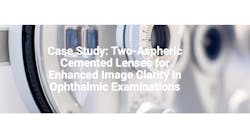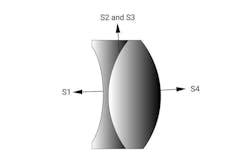Case Study: Two-Aspheric Cemented Lenses for Enhanced Image Clarity in Ophthalmic Examinations
- Avantier manufactures a two-aspheric cemented lens by combining two aspheric lenses, which corrects aberrations and enhances optical performance.
- Specifically designed for innovative eyepieces in ophthalmic examinations, these lenses excel in minimizing distortions to improve image quality and clarity, making them suitable for various fields.
- The project focused on achieving high surface accuracy, different types of surface figures, and high surface quality.
- Despite the challenges of perfecting the fit of two-aspheric lenses, Avantier’s commitment to excellence in lens production is demonstrated through higher processing precision and overall quality.
Introduction
This two-aspheric cemented lens, a significant advancement in the field of optical design, represents a technological marvel in optics. Unlike traditional lenses, these innovative optical components are manufactured by combining two aspheric lenses together, providing unique advantages in correcting aberrations and enhancing optical performance.
One of the primary reasons for developing aspheric cemented lenses is to more effectively address chromatic and spherical aberrations. By employing advanced design principles, these lenses excel in minimizing distortions, thereby improving image quality and clarity. This characteristic makes them particularly well-suited for various fields.
The structure of aspheric cemented lenses involves the precise cementing of two distinct optical elements. Whether through cementing or assembly, lenses produced through this process can generate smaller spot sizes compared to equivalent single lenses. The reduction of aberrations and improvement in optical performance make aspheric lenses the preferred choice in various fields requiring precision and high image quality.
Project Overview
These two-aspheric cemented lenses are specifically designed for innovative eyepieces in ophthalmic examinations. They are versatile, suitable not only for large fixed equipment but also seamlessly adaptable to convenient head-mounted devices. The design incorporates aspheric curvature to optimize the lens performance. By employing this advanced design, it effectively reduces or eliminates aberrations that traditional spherical lenses may cause, significantly enhancing the imaging quality in ophthalmic examinations.
This innovative design holds the promise of delivering more accurate and clear observation results in the field of ophthalmology, empowering eye care professionals with exceptional diagnostic and therapeutic capabilities. Whether utilized with large-scale equipment or portable head-mounted devices, these two-aspheric cemented lenses serve as advanced and efficient tools for medical practices in the field of ophthalmology.
Design & Manufacturer
Differing from traditional spherical cemented lenses, as shown in the diagram, the optical components of the device consist of a spherical surface S1, aspheric surfaces S2&3, and a spherical surface S4. The edge of the aspheric surfaces S2&3 is specially designed, making the processing requirements extremely stringent. Considering that S2 and S3 are two aspherical surfaces with high demands for surface profiles and accuracy, and requiring a seamless fit in between, we have adopted an integrated molding and integrated cemented process to ensure product quality.
The optical elements, S1, S2&3, and S4, are crucial components of the device. The unique design of the asphericS2&3 edge imposes rigorous demands on the manufacturing process in terms of shape and surface quality. To ensure optimal optical performance, a series of precision manufacturing processes have been employed.
In the optical design, S2&S3 are complex aspherical surfaces, imposing high requirements on their shape and surface accuracy. Furthermore, ensuring a perfect fit without any minute gaps between them adds to the challenge. To address this complexity, we have introduced an integrated molding and bonding manufacturing process.
The application of this integrated molding and bonding process not only enhances the manufacturing precision of the product but also ensures a perfect fit between all optical surfaces. By rigorously controlling each step of the manufacturing process, we guarantee the stability of the optical element’s performance and quality. This not only contributes to achieving highly precise optical design but also demonstrates our commitment to product quality and excellence in professional manufacturing capabilities.
Suggestion to Application- Head-worn Devices Example
We place particular emphasis on lightweight and compact design in our engineering, aiming to provide users with a more portable and comfortable experience. Here are some specific optimizations and upgrades in this regard:
- Lightweight Design: We have implemented a lightweight treatment on the lenses and related components to reduce the overall burden of the head-worn device. This allows users to wear the device for extended periods without fatigue, enhancing overall comfort.
- Compact Optimization: By optimizing the dimensions and overall structure of the lenses, we ensure the compactness of the device. This design not only helps reduce the weight of the equipment but also facilitates easy integration into various head-worn devices, be it MR, AR, or VR.
- Performance Enhancement: We have upgraded the lens technology to ensure a clearer and more realistic visual experience in MR, AR, and VR environments. By minimizing optical distortions and improving image quality, we strive to present users with a more authentic virtual world.
Conclusion
This two-aspheric cemented lens holds significant importance for the manufacturing, processing, and design aspects of Avantier, representing the progress in our company’s capabilities. It signifies Avantier’s commitment to excellence in lens production, featuring higher processing precision, high surface accuracy, different types of surface figures, and high surface quality. Distinct from their traditional counterparts, these lenses are crafted by bonding two aspheric lenses together, providing unique advantages in correcting aberrations and enhancing optical performance.
The primary objective in developing aspheric cemented lenses is to effectively solve chromatic and spherical aberration problems. The advanced design principles successfully minimize distortions, resulting in improved image quality and resolution. These lenses, capable of resolving aberration issues, demonstrate outstanding performance across various fields. The precise bonding of the two optical components in their structure leads to smaller spot sizes and superior optical performance.
Applied in innovative eyepieces for ophthalmic examinations, these lenses are suitable for both large fixed equipment and highly adaptable head-mounted devices. The aspherical design optimizes lens performance, effectively reducing aberrations and enhancing the high image quality of ophthalmic examinations. This represents a significant stride forward for Avantier, showcasing our dedication to advancing optical technology and to delivering superior optical solutions.

